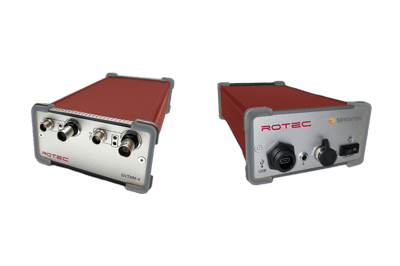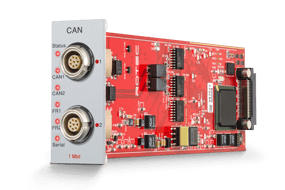Messtechnik
Sensoren, Signal-Conditioning, RASdelta Messsystem (DAQ) mit Messkarten für alle relevanten Anwendungsfälle in der Entwicklung und Optimierung von modernen, effizienten und zuverlässigen Antriebssträngen: Die ROTEC Messtechnik Produkte ermöglichen dem Anwender eine nahtlos integrierte Messkette von Drehzahlsensor bis DAQ mit einer aufeinander abgestimmten Messlösung.
Überzeugen Sie sich von der Leistungsfähigkeit unserer Produkte und vereinbaren Sie einen individuellen Beratungstermin.
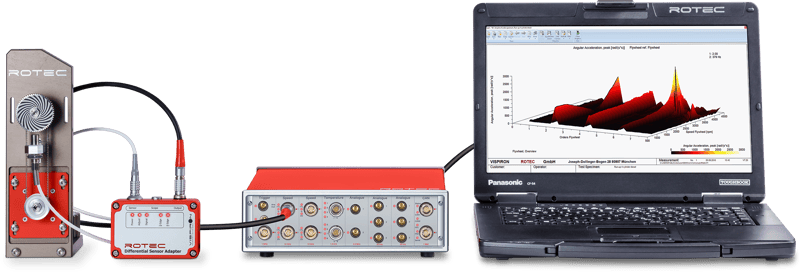
Sensoren
-
Click to view DifferentialsensorDifferentialsensor
-
Click to view LasersensorLasersensor
-
Click to view GMR SensorGMR Sensor
Die magneto-resistiven Differentialsensoren von ROTEC dienen zum Erfassen von Drehzahlen an ferromagnetischen Zahnrädern und sind in unterschiedlichen Bauformen für die anspruchsvollsten Einbausituationen erhältlich.

TYP A
- Zweiteilige Ausführung - die Vorzugsrichtung ist nach der Montage des Sensors einstellbar
- Geeignet für den Standard-Temperaturbereich -15°C bis 100°C
- Optional mit Drehrichtungserkennung (4-fach Sensor)
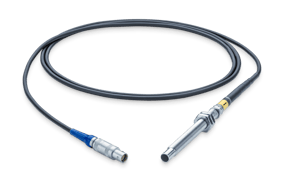
TYP B
- kurze Sensorlänge
- Standard-Temperatursensor (Temperaturbereich -15°C bis 100°C) mit abnehmbarem Anschlusskabel
- Hochtemperatursensor (Temperaturbereich -15°C bis 160°C) mit integriertem Kabel, inkl. Adapterkabel
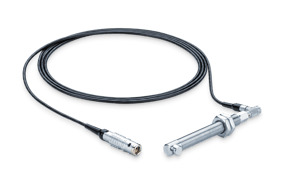
TYP C
- Abgewinkelter 90° Sensorkopf
- Standard-Temperatursensor (Temperaturbereich -15°C bis 100°C) mit abnehmbarem Anschlusskabel
- Hochtemperatursensor (Temperaturbereich -15°C bis 160°C) mit integriertem Kabel, inkl. Adapterkabel
Die ROTEC Lasersensoren dienen zum Erfassen von Drehzahlen durch Abtastung eines schwarz-weiß (Zebra) Strichmusters. Es können sowohl Strichbänder als auch Strichscheiben verwendet werden. Die Strichmuster sind in verschiedenen Standards erhältlich. Die Behandlung der Stoßstelle bei Verwendung von Strichbändern ist über einen Korrekturmechanismus in der RAS Software problemlos möglich.
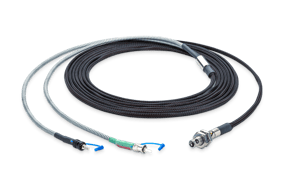
Lasersensor (SeLas 4/5)
- Abtastung des Objekts von vorne oder über einen Umlenkspiegel im 90°-Winkel möglich
- Lichtwellenleiter mit Textil- oder Metallummantelung erhältlich

Strichmuster
- Hochwertige Strichmuster verbessern die Qualität des Drehzahlsignals
- Strichbänder und Strichscheiben erhältlich in Standarddimensionen
- Kundenspezifische Strichmuster auf Anfrage
Der Sensitec Sensor GLM711AVB ist für die Verwendung mit passiven Skalen mit einem Raster von 1 mm vorgesehen. Ein Bias-Magnet für das erforderliche Magnetfeld und das Sensorlement sind in einem sehr kleinen Gehäuse kombiniert. Die Integration unterstützt eine optimale Ausrichtung zwischen Sensor und Magnet, was zur Erzeugung eines sehr hochwertigen Sensorsignals beiträgt.
In Kombination mit einer ferromagnetischen Zahnstruktur liefert der Sensor zwei um 90 Grad phasenverschobene analoge Signale (Sinus und Kosinus).
Der typische Anwendungsbereich des Sensors ist die Messung von Ventilerhebungskurven im befeuerten Motorbetrieb. Auch die Messung von Ventilrotation ist möglich.
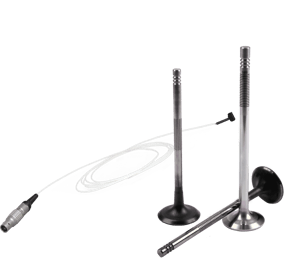
Signal Conditioning / Elektroniken
-
Click to view Differential Sensor AdapterDifferential Sensor Adapter
-
Click to view Laser TachometerLaser Tachometer
-
Click to view Rotary Encoder AdapterRotary Encoder Adapter
-
Click to view 4-fold Sensor4-fold Sensor
-
Click to view Encoder Phase ShifterEncoder Phase Shifter
-
Click to view Ventiltrieb MessmodulVentiltrieb Messmodul
Der Differential Sensor Adapter (DSA) wandelt das sinusförmige Signal des ROTEC Magnetsensors in eine Impulsfolge von Nadelimpulsen mit TTL-Pegel, die von der RASdelta Drehzahlmesskarte verarbeitet wird.
Eine LED Anzeige erleichtert dem Anwender die optimale Einrichtung des Differentialsensors gegenüber der Verzahnung, um eine bestmögliche Signalqualität zu erreichen.
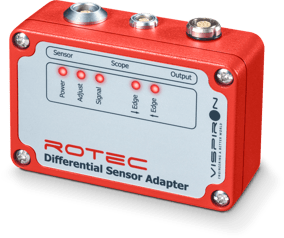
Der Inline TTL Digitizer (Inline-DSA) ist die kompakte Ausführung des ROTEC Differential Sensor Adapters (DSA) und eignet sich besonders für den mobilen Einsatz. Die Elektronik wandelt das sinusförmige Signal des ROTEC Magnetsensors in eine TTL-Impulsfolge, die von der RASdelta Drehzahlmesskarte verarbeitet wird.
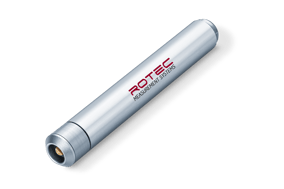
Das ROTEC Laser Tachometer 3 (ELLAS3) dient zur optischen Messung der Drehzahl. Die Elektronik erzeugt ein leistungsgeregeltes Laserlicht, das vom ROTEC Lasersensor auf ein am Messobjekt angebrachtes schwarz-weiß Strichmuster übertragen wird. Die Hell-Dunkel-Übergänge des Messobjekts werden im Reflexverfahren abgetastet. Daraus resultiert eine Impulsfolge mit TTL-Pegel, die von der RASdelta Drehzahlmesskarte verarbeitet wird.
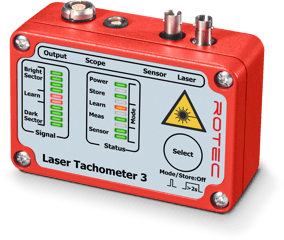
Der Rotary Encoder Adapter (ELDGADP2) dient zur Erfassung von TTL- oder SIN/COS-Drehgebersignalen.
Aus den Signalen des Inkrementalgebers erzeugt die Elektronik eine digitale Impulsfolge mit TTL-Pegel. Der Rotary Encoder Adapter erfasst die Gebersignale vorwärts und rückwärts und leitet daraus Richtungsinformationen ab. Die Signale für die Drehzahl und Drehrichtung sowie der Referenzimpuls werden von der RASdelta Drehzahlmesskarte erfasst und verarbeitet.
Der Referenzimpuls lässt sich zudem an einer separaten Buchse abgreifen und als Starttrigger für Messungen verwenden.
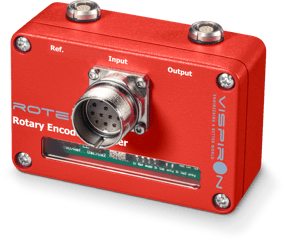
Der Inline DGADP ist die kompakte Ausführung des ROTEC Rotary Encoder Adapters und eignet sich besonders für den mobilen Einsatz. Zudem ist der Adapter in zwei Varianten erhältlich: für TTL- und für HTL- Inkrementaldrehgeber.
Aus den Signalen des Inkrementalgebers erzeugt die Elektronik eine digitale Impulsfolge mit TTL-Pegel, die als Messsignal dient. Der Inline DGADP erfasst die Gebersignale vorwärts und rückwärts und leitet daraus Richtungsinformationen ab.
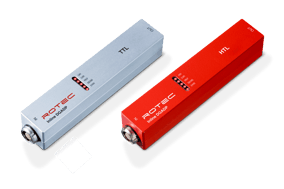
Die 4-fach Sensor-Elektronik dient zur Messung von Drehzahlen mit Richtungserkennung. Die Elektronik wandelt das vom Sensor erzeugte analoge Sinussignal in eine digitale Impulsfolge mit TTL-Pegel, das als Messsignal dient. Zusammen mit dem analogen Cosinussignal wird zusätzlich die Richtungsinformation abgeleitet. Über einen Scope-Ausgang können das analoge Sensorsignal und die digitale TTL-Pulsfolge separat abgegriffen werden.
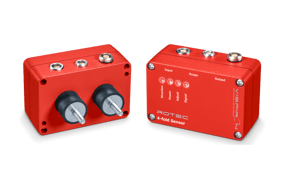
- Misst Drehzahlen mit Richtungserkennung
- Wandelt analoge Sinussignal in digitale Impulsfolge mit TTL-Pegel
- Leitet Richtungsinformation vom Messignal ab
- Versorgt Sensor mit Spannung
- Spannungsversorgung durch Drehzahlmesskarte
Der ROTEC Laser Tachometer 3 dient zur optischen Messung der Drehfrequenz bzw. Drehzahl. Die Elektronik erzeugt ein leistungsgeregeltes Laserlicht, das vom Sensor auf ein am Messobjekt angebrachtes schwarz/weiß-Muster übertragen wird. Die Hell-Dunkel-Übergänge des Messobjekts werden im Reflexverfahren abgetastet. Das empfangene optische Signal wird erst in ein Analogsignal und dann in ein digitales Signal umgewandelt. Daraus resultiert eine Impulsfolge mit TTL-Pegel und geschwindigkeitsproportionaler Frequenz. Am Scope-Ausgang der Elektronik können das analoge Sensorsignal sowie die digitale Impulsfolge separat abgegriffen werden.
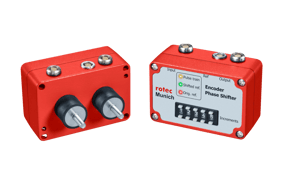
- Verzögert das originale Referenzsignal um eine einstallbare Anzahl an Drehzahlpulsen
- Stellt synthetischen Referenzimpuls an separater Buchse zur Verfügung
- Versorgt Rotary Encoder Adapter und Sensor mit Spannung
- Spannungsversorgung durch Drehzahlmesskarte
Das Ventiltrieb Messmodul (ELVTMM, ehemals Sensitec SPP3001) dient als Auswerteeinheit für Messungen am Ventiltrieb. Die Elektronik konditioniert das Sensorsignal und errechnet einen Online Ventilhub mit einer Genauigkeit von +/- 10 μm, der am BNC Stecker als Ausgangsspannung zwischen 0-10 V bereitgestellt wird. Das Modul ist in 2- und 4- Kanal Variante verfügbar.
Zur weiteren Verarbeitung des Ventilhubsignals bietet das ROTEC RAS Software Paket "Ventiltriebsanalyse" tiefgehende dynamische Analysemöglichkeiten.
Der GMR Sensor Adapter eignet sich für Ventilhubmessungen mit dem GLM711AVB GMR Sensor. Die Elektronik dient dazu, die erfassten Rohsignale zu verstärken und ein rauschfreies Signal sowie eine ausreichende Bandbreite zu gewährleisten. Die verstärkten Sensor-Signale werden über separate Sinus- und Cosinus-Ausgänge ausgegeben und können mit der 3,2 MHz RASdelta Analogmesskarte aufgezeichnet werden.
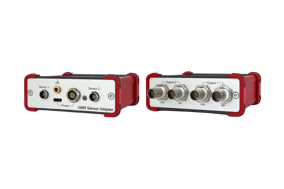
-
Click to view TriggerkarteTriggerkarte
-
Click to view DrehzahlkarteDrehzahlkarte
-
Click to view AnalogkarteAnalogkarte
-
Click to view TemperaturkarteTemperaturkarte
-
Click to view DMS-KarteDMS-Karte
-
Click to view CAN-BUS-KarteCAN-BUS-Karte
Die RASdelta Triggerkarte synchronisiert alle Messdaten zwischen den Kanälen, Erfassungsmodulen und angeschlossenen Frontends. Als Masterkarte ist sie ein integraler Bestandteil des RASdelta.
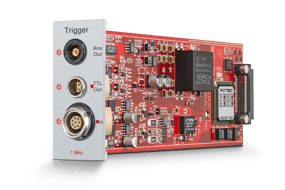
- Synchronisiert alle Messkarten, Kanäle und kaskadierten Systeme
- 1x TTL-Triggereingang mit einstellbaren Schwellenwerten
- 2x TTL-Ausgang + 1x Analogausgang
Spannungsversorgung für Elektronikeinheiten (DC 5 V und 12 V; 5 W) - Datenübertragung über Ethernet
Das RASdelta Speed Board erfasst präzise mehrkanalige und digitale Drehzahlmessdaten für alle Getriebe-, Steuerungs- und Nebenantriebsprüfungen. Es ist damit die Basis für die Drehschwingungsanalyse. Die Daten werden über eine magnetische, winkeläquidistante Abtastung, einen Inkrementalgeber oder einen Laser erfasst.
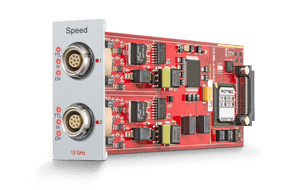
- 2-Kanal-Messkarte mit 12 GHz Zählertakt (Zeitauflösung = 0,081 Nanosekunden)
- Signaleingänge für Richtungs- und Referenzimpulserkennung
- Einstellbare Werte für Triggerschwelle und Flanke
- Betriebsarten: Drehzahl, Frequenz, Tastverhältnis, Ein/Aus-Verhältnis
Das RASdelta Analog Board misst analoge Größen wie Luft- und Körperschall, Beschleunigung, Temperatur, Weg oder Druck. Diese Größen können verwendet werden, um die Position einer Schallquelle zu bestimmen oder den Ventiltrieb oder den Zylinderdruck zu analysieren. Die analogen Messdaten werden durch äquidistante Abtastung erfasst.
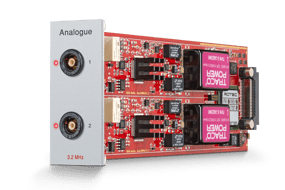
- 2 analoge Spannungseingänge, galvanisch getrennt
- AC- und DC-Kopplung, Spannungsversorgung für IEPE (ICP) Sensoren
- Einstellbare Spannungsbereiche für Eingangssignale
- 16 Bit SigmaDelta ADC
- 3,2 MHz max. Abtastrate bei einkanaliger Nutzung
- 1,6 MHz max. Abtastrate pro Kanal bei Zweikanalbetrieb
- 1,2 MHz analoge Bandbreite
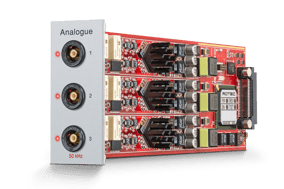
- 3 analoge Spannungseingänge, galvanisch getrennt
- AC- und DC- Kopplung, Stromversorgung für IEPE (ICP) Sensoren
- Einstellbare Spannungsbereiche für Eingangssignale
- 24 Bit SigmaDelta ADC
- 50 kHz max. Abtastrate pro Kanal
- 24 kHz analoge Bandbreite
Das RASdelta DMS (strain gauge) Board ist ein integrierter Zweikanal-Gleichspannungsverstärker für die Signalerfassung von Dehnungsmessstreifen-basierten, piezoresistiven, magnetoresistiven oder potentiometrischen Aufnehmern. Dazu gehören Kraft-, Drehmoment-, Druck-, Weg- und Winkelsensoren oder Maßstäbe. Die Karte benötigt keine zusätzlichen Messverstärker.
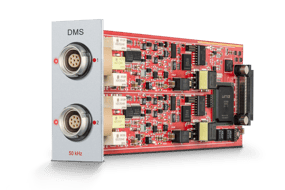
Max. Abtastrate: 50 kHz pro Kanal
Unterstützt Vollbrücken- und Halbbrückenanwendungen
Einstellbare Brückenversorgungsspannung: 1 V, 2,5 V, 5 V, 10 V
Unterstützt Vierdraht- und Sechsdraht-Konfiguration
Automatischer Nullabgleich
Erkennung von Leitungsunterbrechungen/Burn-Out
- Zweidraht- und Vierdrahtkonfiguration für Pt 100/1000
Das RASdelta DMS-Karte ist ein integrierter Zweikanal-Gleichspannungsverstärker für die Signalerfassung von Dehnungsmessstreifen-basierten, piezoresistiven, magnetoresistiven oder potentiometrischen Aufnehmern. Dazu gehören Kraft-, Drehmoment-, Druck-, Weg- und Winkelsensoren oder Maßstäbe. Die Karte benötigt keine zusätzlichen Messverstärker.
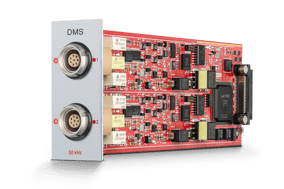
- 2-Kanal-Messkarte
- Max. Abtastrate: 50 kHz pro Kanal
- Unterstützt Vollbrücken- und Halbbrückenanwendungen
- Einstellbare Brückenversorgungsspannung: 1 V, 2,5 V, 5 V, 10 V
- Unterstützt Vierdraht- und Sechsdraht-Konfiguration
- Automatischer Nullabgleich
- Erkennung von Leitungsunterbrechungen/Burn-Out
Die CAN-BUS-Karte zeichnet CAN- und OBD-II-Variablen auf und wertet diese in Bezug auf die Drehschwingungsanalyse aus. Damit können vorhandene Größen ohne weitere Sensorapplikationen in die Messung einbezogen werden. Neben OBD II, Raw CAN und SAE J1939 Protokoll ist es möglich, FD CAN Daten direkt über den Mess-PC und separate Fremdhardware aufzuzeichnen.
- 2-Kanal-Messkarte
- Max. Baudrate: 1 Mbit/s pro Kanal
- Einstellbare Post-Sampling-Rate
- CAN-Standard 2.0 A (11-Bit-Identifier) und 2.0 B (29-Bit-Identifier); OBDII; J1339; (CAN-FD über PC USB-Anschluss)
- Modi: aktiver/passiver Mithörer
- Einstellbarer BUS-Abschluss (120 Ohm)
RASdelta Gehäuse
Der RASdelta Mainframe verbindet Sensoren und Messkarten. Das Gehäuse bietet Platz für mind. 8 Messkarten, die beliebig kombiniert werden können. Durch den integrierten Lüfter ist es zudem temperaturunempfindlich. In diesem Fall fungiert eines der Frontends als Master und synchronisiert die anderen Geräte im Cluster. Mit der Datenlogger-Funktion können Messungen direkt am Touch-Display konfiguriert und durchgeführt werden. Die Messdaten werden auf einer SD-Karte gespeichert und können später zur Auswertung auf einen PC übertragen werden.
-
Click to view 8 Steckplätze8 Steckplätze
-
Click to view 16 Steckplätze16 Steckplätze
-
Click to view ClusterCluster
-
Click to view Datenlogger-FunktionDatenlogger-Funktion
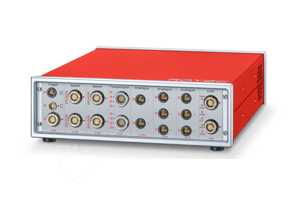
- Platz für 8 Messkarten
- Integriertes Touchpanel-Display
- Temperaturunempfindlich, durch den integrierten Lüfter
- Messkarten können bei Bedarf ausgetauscht werden
- Optional mit Datenlogger-Funktion
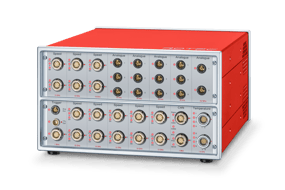
- Platz für 8 Messkarten
- Integriertes Touchpanel-Display
- Temperaturunempfindlich, durch den integrierten Lüfter
- Messkarten können bei Bedarf ausgetauscht werden
- Optional mit Datenlogger-Funktion
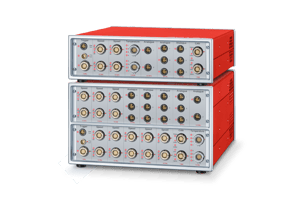
- Steckplätze können durch Kaskadierung der RASdelta-Frontends erweitert werden
- Ein Frontend fungiert als Master
- Integriertes Touchpanel-Display
- Temperaturunempfindlich, durch den integrierten Lüfter
- Messkarten können bei Bedarf ausgetauscht werden
- Opt. mit Datenlogger-Funktion
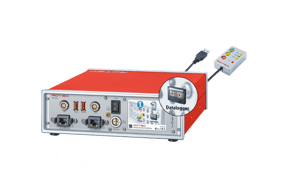
- Messungen werden direkt am Touch-Display konfiguriert und durchgeführt
- Messdaten werden auf einer SD-Karte gespeichert und können später zur Auswertung auf einen PC übertragen werden.








